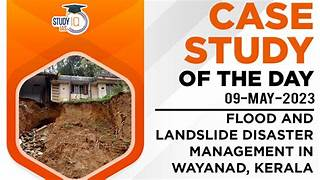landside-hit Wayanad 2024

Table of Contents
Introduction landside-hit Wayanad 2024
In the wake of a devastating landslide that has ravaged Wayanad district in Kerala, Indian Prime Minister Narendra Modi undertook a spot visit to assess the damage and provide support. His visit underscores the severity of the situation, characterized by extensive destruction and a significant humanitarian crisis. Modi’s statement that “This disaster is not normal” highlights the gravity of the situation and reflects the government’s commitment to addressing the crisis. This article delves into the circumstances surrounding the landslide, the Prime Minister’s visit, and the ongoing response efforts.
Context of the Landslide
Wayanad, a picturesque district in Kerala known for its lush green landscapes and coffee plantations, has recently been struck by a catastrophic landslide. The disaster occurred amid heavy monsoon rains, which have been exacerbated by climate change and deforestation. The landslide has caused substantial damage to infrastructure, homes, and agricultural lands, displacing hundreds of residents and causing numerous fatalities.
The region’s susceptibility to landslides is heightened by its hilly terrain, which, when combined with intense rainfall, can lead to soil erosion and instability. In recent years, the frequency and intensity of such natural disasters have increased, drawing attention to the need for improved disaster preparedness and response mechanisms.
Prime Minister’s Spot Visit landside-hit Wayanad 2024
Prime Minister Narendra Modi’s visit to Wayanad was a crucial moment in the disaster response effort. Arriving at the site, Modi was met with a scene of devastation that included collapsed roads, destroyed homes, and extensive debris. His visit served multiple purposes: to provide reassurance to affected communities, to evaluate the situation firsthand, and to coordinate the response efforts of various government agencies.
During his visit, Modi expressed deep empathy for the victims and highlighted the need for a comprehensive and coordinated response. His statement that “This disaster is not normal” emphasized the extraordinary nature of the calamity and the necessity for robust measures to address the crisis.
Observations and Statements
Severity of the Situation: Modi’s observations reflected the dire circumstances faced by the residents of Wayanad. He noted the scale of the destruction and the urgent need for relief and rehabilitation efforts. His comments underscored the severity of the situation and the challenges in providing immediate assistance.
Government Response: The Prime Minister’s visit highlighted the government’s commitment to addressing the disaster. Modi assured that the central and state governments would collaborate to provide aid and support to the affected communities. This included deploying rescue teams, providing medical assistance, and facilitating the reconstruction of damaged infrastructure.
Humanitarian Support: Modi emphasized the importance of humanitarian support and relief measures for those displaced by the landslide. The government’s focus was on providing temporary shelters, food, and medical care to those affected. Efforts were also directed towards ensuring the safety and well-being of the most vulnerable populations, including children and the elderly.
Climate Resilience and Preparedness: The Prime Minister’s visit also brought attention to the broader issue of climate resilience and disaster preparedness. Modi highlighted the need for enhanced measures to mitigate the impact of such natural disasters, including better land management practices, improved infrastructure, and effective early warning systems.
Ongoing Response Efforts landside-hit Wayanad 2024
In the aftermath of the landslide, several response efforts have been initiated by both the central and state governments:
Rescue Operations: Immediate rescue operations were launched to search for survivors and provide aid to those stranded. Teams from the National Disaster Response Force (NDRF) and local rescue squads were deployed to the affected areas.
Relief Camps: Temporary relief camps have been set up to accommodate displaced residents. These camps provide essential services such as shelter, food, and medical care.
Infrastructure Repair: Efforts are underway to assess and repair damaged infrastructure, including roads, bridges, and utility services. Restoring connectivity is crucial for the delivery of aid and the overall recovery process.
Financial Assistance: The government has announced financial assistance for the affected families. This includes compensation for loss of property and agricultural damage, as well as funding for reconstruction efforts.
Long-Term Rehabilitation: Beyond immediate relief, long-term rehabilitation plans are being formulated. These plans aim to rebuild communities, restore livelihoods, and implement measures to prevent future disasters.







